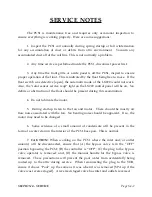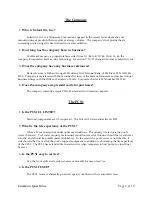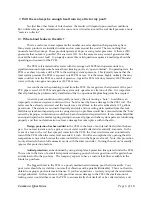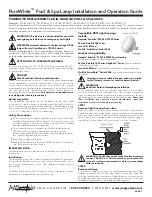
Common Questions
Page 5 of 10
9.
Will there always be enough heat from my attic for my pool?
No: Just like other forms of Solar heaters, the results will depend upon weather conditions.
But, unlike solar panels, orientation to the sun is not a critical factor and the roof itself presents a more
"massive collector".
10.
What about leaks in the attic?
This is a real concern and represents the number one sales objection that people may have.
Many water products are installed in attics and on roofs around the world. There is nothing that
unusual about the concept. These products operate at 60 psi or even greater pressures. Is there a 100%
guarantee that no leak is possible? The answer is NO. For the same reason you can't guarantee that
your kitchen sink won't leak! To properly answer this valid question requires a knowledge about the
operating environment of the PCS1.
The PCS1 coil is tested under water with dry nitrogen at 350 PSI and operates under no
significant amount of pressure because the swimming pool is an "open container". In operating tests, the
PCS1 was shown to only add 2-6 PSI to the existing system's pressure. This typically means that the
total system pressure the PCS1 is exposed to is 20 PSI or less. It is therefore, highly unlikely, that any
leaks could occur in the PCS1 as a result of pressure. Again the PCS1 is factory tested at 350 PSI under
water with dry nitrogen and operates at 20 PSI or less.
A second issue is the plumbing to and from the PCS1. Here again are the dynamics of the pool.
PVC pipe is rated at 120 PSI and again the system only operates at a fraction of this. It is important
that all plumbing be professionally installed and that no questionable plumbing joints be accepted.
An acidic pool condition could quickly eat away the coil causing a "hole". In addition, an
improperly winterized system could result in a "hole" caused by freeze damage to the PCS1 coil. The
latter case has already occurred and the result was a small leak in the attic estimated at 1-2 gallons
per minute. The system was turned off quickly and only a minor ceiling stain resulted from this leak.
Had this system been inspected prior to spring startup, no problem would have occurred since the "hole"
caused by improper winterization would have been detected and repaired first. It is recommended that
an annual inspection be made at spring startup to ensure all pipes and other system parts are functioning
properly and that no deterioration or freeze damage has taken place within the attic.
Design protection has been added
to the PCS1 in the form of an internal float within the base
pan. In a normal instance, only a pint or two of water would collect and eventually evaporate. In the
event of a leak in the coil that sprayed water into the PCS1, the float would rise and automatically
turn off the PCS1 when the water level exceeds 3/8 inch. Cutoff is accomplished by opening the attic
temperature sensor which causes the solar controller to turn the bypass valve off. Note: this protection
is only afforded when in full automatic mode with the solar controller. Turning the unit on ÒmanuallyÓ
ignores this protection feature.
Added protection
can be obtained by using a simple leak protection liner placed under the PCS1.
This can be in the form of a small kids plastic swimming pool which is tapped into with a garden hose
and drained off to the pool area. The company expects to have a custom leak liner available in the
future for purchase.
The biggest threat to the PCS1 is a poorly maintained swimming pool that turns acidic. Your
pool water should be crystal clear, not smell of chlorine and be potable [drinkable]. This is not hard to
obtain from proper pool water maintenance. If you have questions -- contact your pool chemical dealer
and get educated. In the event an acidic pool does causes damage to the PCS1, the small amount of
leaking water would either cause the PCS1 to automatically shut itself off or be collected safely and
Summary of Contents for PCS1
Page 7: ...SECTION 1 SYSTEM ARRIVAL Page S1 1 SECTION ONE SYSTEM ARRIVAL...
Page 22: ...SECTION 2 HEATING DATA Page S2 1 SECTION TWO HEATING DATA...
Page 28: ...BTUS Vs GPM BTUS Vs T SECTION 2 HEATING DATA Page S2 7...
Page 34: ...SECTION 3 INSTALLATION Page S3 1 SECTION THREE INSTALLATION...
Page 65: ...Attic Installation Photos SECTION 3 INSTALLATION Page S3 31...
Page 66: ...Attic Installation Photos SECTION 3 INSTALLATION Page S3 32...
Page 88: ...SECTION 4 SERVICE Page S4 1 SECTION FOUR SERVICE...
Page 99: ...Common Questions Page 1 of 10 COMMON QUESTIONS...
Page 109: ...Dictionary of Terms Page 1 of 4 DICTIONARY OF TERMS...














































